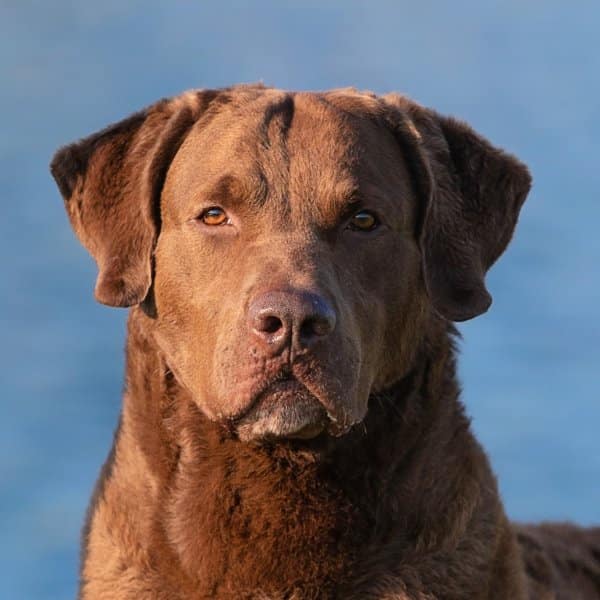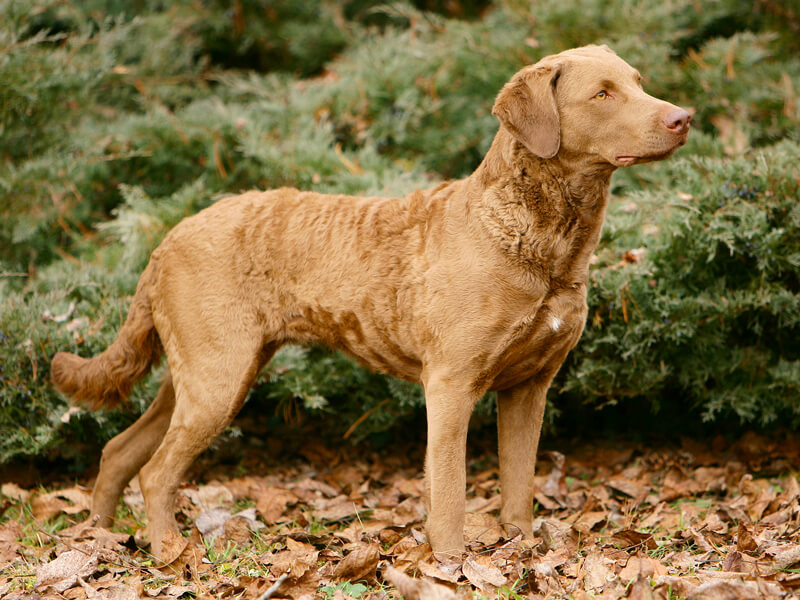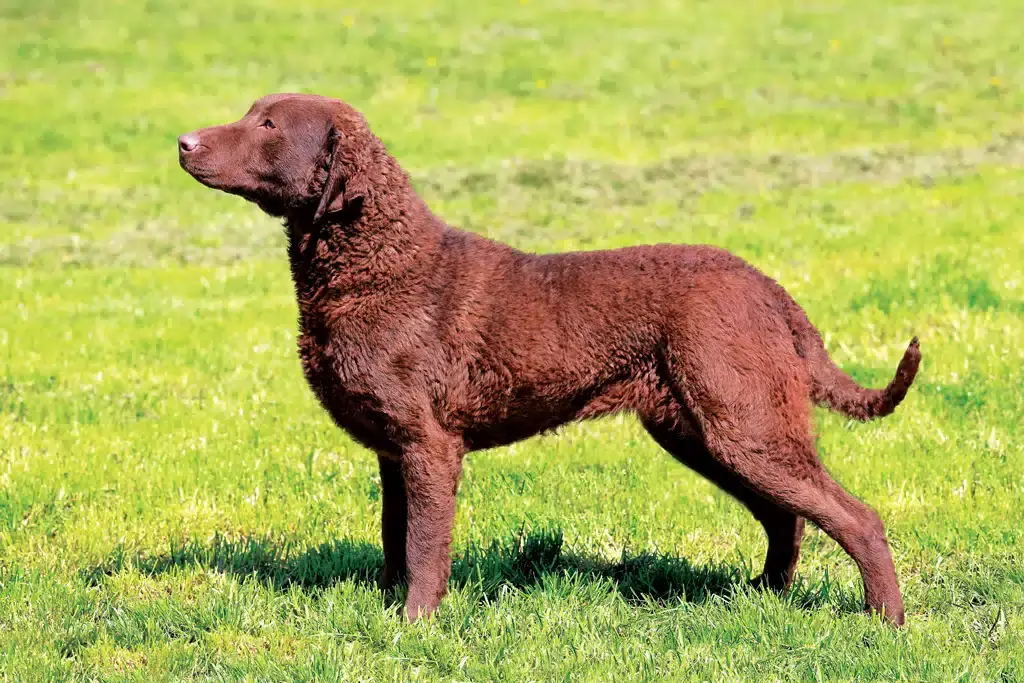Chesapeake Bay Retriever Dog Breed | Description, Temperament, Lifespan, & Facts
The Chesapeake Bay Retriever, affectionately known as the “Chessie,” is a breed renowned for its versatility, intelligence, and distinctive characteristics. Originating in the United States, this breed was developed to excel in waterfowl hunting in the harsh conditions of the Chesapeake Bay area. Their resilience, coupled with a loyal and affectionate nature, makes them a cherished companion for families and outdoor enthusiasts alike.
Contents
Physical Characteristics
Size and Weight
Chesapeake Bay Retrievers are medium to large-sized dogs. Males typically stand between 23 to 26 inches at the shoulder and weigh around 65 to 80 pounds. Females are slightly smaller, standing 21 to 24 inches and weighing 55 to 70 pounds. Their muscular build and sturdy frame reflect their robust and hardy nature.
Coat and Color
The Chessie is distinguished by its dense, waterproof double coat, which is essential for swimming in cold waters. The outer coat is short, harsh, and oily, while the undercoat is thick and woolly. Coat colors range from brown and sedge (a reddish-yellow) to dead grass (straw-like color). These colors help the dog blend into its natural hunting environment.
Distinguishing Features
The Chesapeake Bay Retriever’s eyes are a striking yellow-amber color, exuding intelligence and alertness. Their webbed feet enhance their swimming abilities, and their broad, deep chest allows for powerful lung capacity, essential for endurance in the water.
Temperament and Personality

General Disposition
Chessies are known for their strong will and independence, traits that stem from their working heritage. They are intelligent, wise, and often reserved with strangers, displaying a protective instinct towards their family and home.
Interaction with Families and Children
Despite their rugged exterior, Chesapeake Bay Retrievers are deeply affectionate and loyal to their families. They form strong bonds with their human companions and are particularly good with children, displaying patience and gentleness. Their protective nature makes them excellent watchdogs.
Compatibility with Other Pets
While generally good with other pets, early socialization is crucial for a Chesapeake Bay Retriever. Their strong prey drive, inherited from their hunting background, means they may chase smaller animals. However, with proper training, they can coexist peacefully with other household pets.
Training and Exercise Needs

Training Tips and Techniques
Chesapeake Bay Retrievers are highly trainable but require a firm and consistent hand. Positive reinforcement methods, such as treats and praise, work best. Training should start early to harness their intelligence and eagerness to please.
Exercise Requirements
This breed is energetic and requires ample exercise to maintain physical and mental health. Daily activities should include long walks, runs, and, ideally, swimming. Engaging them in retrieving games can help satisfy their instincts.
Mental Stimulation Activities
To prevent boredom, Chessies benefit from activities that challenge their minds. Puzzle toys, advanced obedience training, and interactive play are excellent ways to keep them mentally stimulated.
Health and Lifespan
Common Health Issues
Chesapeake Bay Retrievers are generally healthy but can be prone to certain genetic conditions. Hip dysplasia, progressive retinal atrophy (PRA), and hypothyroidism are some of the health issues to watch for. Regular veterinary check-ups are essential to monitor their health.
Preventative Health Measures
Maintaining a healthy diet, regular exercise, and routine vet visits are crucial for preventing health problems. Hip and eye exams are particularly important for this breed.
Average Lifespan
With proper care, a Chesapeake Bay Retriever can live a healthy life of 10 to 13 years. Ensuring they have a balanced diet, adequate exercise, and regular medical care can contribute to their longevity.
Care and Grooming
Grooming Requirements
The Chessie’s coat requires minimal grooming. Regular brushing helps remove loose hair and maintain the coat’s health. Bathing should be done occasionally to preserve the natural oils that keep their jacket waterproof.
Dietary Needs
A balanced diet is essential for the Chessie’s health. High-quality dog food, rich in protein and nutrients, supports their active lifestyle. Portion control is important to prevent obesity.
Seasonal Care Tips
During the colder months, their thick coat provides ample protection, but they still require a warm, dry place to rest. In hotter weather, ensure they have access to plenty of water and shade to prevent overheating.
Living Conditions
Ideal Home Environment
Chesapeake Bay Retrievers thrive in homes with access to outdoor space. They are best suited for active families who can provide plenty of physical and mental stimulation. While they can adapt to various living situations, they are happiest with room to roam.
Adaptability to Various Living Situations
Although they can adapt to apartment living if sufficiently exercised, a suburban or rural environment with access to water is ideal. They enjoy the freedom to explore and play in open spaces.
Fun Facts and Trivia
Unique Traits
- Chessies have a natural love for water and are exceptional swimmers.
- Their webbed feet and strong build make them adept at retrieving waterfowl in tough conditions.
- They were the first retriever breed recognized by the American Kennel Club in 1878.
Famous Chesapeake Bay Retrievers
- “Sailor” and “Canton” were the two Newfoundland pups that were the foundation of the breed.
- Chessies have been featured in various films and books, highlighting their remarkable abilities and loyal nature.
Adoption and Buying Guide
Finding Reputable Breeders
When looking to add a Chesapeake Bay Retriever to your family, it’s crucial to find a reputable breeder. Look for breeders who conduct health screenings and provide a healthy, well-socialized puppy.
Adoption Resources
Consider adopting rescue organizations or shelters. Many purebred Chesapeake Bay Retrievers are in need of loving homes.
Cost Considerations
The cost of a Chesapeake Bay Retriever can vary based on the breeder’s reputation, location, and lineage. On average, expect to pay between $800 to $1,500 for a puppy—factor in costs for health care, training, and supplies.
Conclusion
The Chesapeake Bay Retriever is a remarkable breed known for its resilience, intelligence, and loyalty. Whether as a hunting companion, a family pet, or a watchdog, the Chessie excels in various roles, bringing joy and protection to its family. By understanding their needs and characteristics, you can ensure a fulfilling and happy life for this extraordinary breed.
- Golden Retriever Pros and Cons: What Every Pet Parent Should Know - 15 September 2025
- Cane Corso Dog Breed: Health, Care, and Lifespan - 14 September 2025
- Catahoula Leopard Dogs: Description, Temperament, Lifespan, & Facts - 21 July 2025







